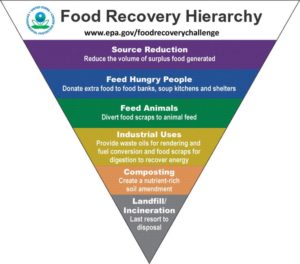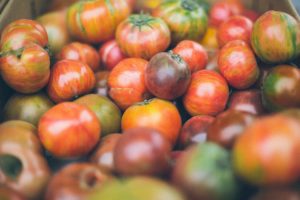To the Point Collaborative
Rethinking Food Culture
Food production produces too much waste
It’s time to RETHINK FOOD. This is the tagline of the documentary “WASTED! The Story of Food Waste.” It could also very well be the perfect time to prioritize this effort. Starting with not only eating the pretty stuff.
Over 90 percent of wasted food in the U.S. ends up in landfills. Globally, this is estimated to be 1.3 billion tons of consumables, a third of which doesn’t even make it to our plates — meaning it languishes in the field.
Those are just two of the many mind boggling food waste statistics our To the Point team learned at the screening of Wasted, at the Clinton Street Theater, on May 31st.
Surplus food is a waste
If you look at the EPA’s food recovery hierarchy pyramid, the very top, and largest section is source reduction; reducing the volume of surplus food generated. That’s because a whopping 10 million tons of produce goes unharvested each year. Of the food that does get picked, only the most beautiful makes it to grocery store shelves.
“Grocery stores routinely trash produce for being the wrong shape or containing minor blemishes,” says Doug Rauch, former president of Trader Joe’s.
But, there is hope for those ugly peppers and scarred peaches. Enter companies like San Francisco’s Imperfect Produce. Imperfect fights food waste by finding a home for undesirable “ugly” produce — at a price that is often at 30% to 50% less than in the store. The fruits and vegetables are sourced directly from farms, and are just as nutritious and delicious as their camera-ready brethren.
Embracing un-pretty produce
Imperfect had a representative at the film screening, and I signed up for a weekly share. (Imperfect Produce does not currently deliver to my town, Sherwood, but they are about to do so, and so they are taking pre-order memberships.) 
One of the great things about the Imperfect program is you can order week-to-week AND choose the foods you want. Unlike some farm share programs, where you “get what you get,” Imperfect allows you to choose what your family likes and will eat. AND, you can pay as you order. You can suspend your order if you are away, or won’t be home much during a particular week.
I’ve made one step so far towards doing my teeny, weeny part. Tell us what you are doing, or would like to do in the food waste reduction effort. And, if you need help making an upcoming event or conference more sustainable and accessible, contact us to see how our services can add to your attendees’ overall experience.
For now, here’s a trivia question for you — and don’t cheat by looking for the answer: How long does it take a head of lettuce to decompose in the landfill?